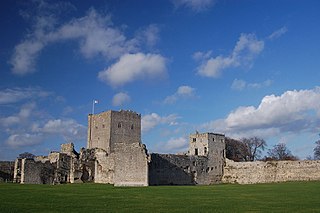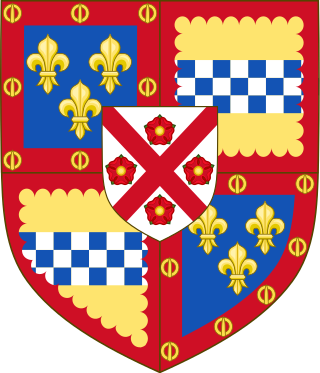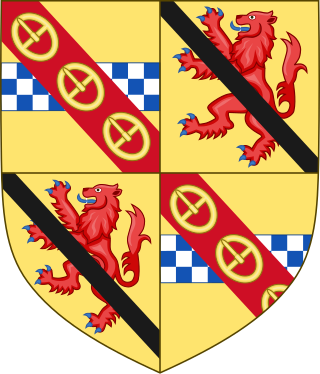Related Research Articles

Earl Castle Stewart, in the County Tyrone, is a title in the Peerage of Ireland. It was created in 1800 for Andrew Thomas Stewart, 9th Baron Castle Stuart.

The Mormaer or Earl of Buchan was originally the provincial ruler of the medieval province of Buchan. Buchan was the first Mormaerdom in the High Medieval Kingdom of the Scots to pass into the hands of a non-Scottish family in the male line. The earldom had three lines in its history, not counting passings from female heirs to sons. Today, it is held by the Erskine family as a peerage. The current holder is Harry Erskine, 18th Earl of Buchan.

The title Earl of Moray, Mormaer of Moray or King of Moray was originally held by the rulers of the Province of Moray, which existed from the 10th century with varying degrees of independence from the Kingdom of Alba to the south. Until 1130 the status of Moray's rulers was ambiguous and they were described in some sources as "mormaers", in others as "Kings of Moray", and in others as "Kings of Alba". The position was suppressed by David I of Scotland some time after his defeat of Óengus of Moray at the Battle of Stracathro in 1130, but was recreated as a feudal earldom by Robert the Bruce and granted to Thomas Randolph, 1st Earl of Moray in 1312.

George Nevill, 5th Baron Bergavenny KG, PC, the family name often written Neville, was an English nobleman and courtier who held the office of Lord Warden of the Cinque Ports.
Patrick III, 7th Earl of Dunbar was lord of the feudal barony of Dunbar and its castle, which dominated East Lothian, and the most important military personage in the Scottish Borders.

Sir Thomas Grey, of Heaton Castle in the parish of Norham, Northumberland, was one of the three conspirators in the failed Southampton Plot against King Henry V in 1415, for which he was executed.
Margaret Stewart, Countess of Angus and Mar was Countess of Angus and Lady of Abernethy in her own right. Her father was Thomas Stewart, 2nd Earl of Angus.
David Kennedy, 3rd Lord Kennedy and 1st Earl of Cassilis was a Scottish peer, the son of John Kennedy, 2nd Lord Kennedy. He was born about 1463, in Maybole, Ayrshire, Scotland. He was a Privy Councillor of King James IV and was created Earl of Cassilis by him in 1502. Killed at the Battle of Flodden, on 9 September 1513.
James Colville, 1st Lord Colville of Culross (1551–1629) was a Scottish soldier, courtier, and diplomat.
John Erskine, 5th Lord Erskine was a Scottish nobleman.
Sir Anthony Browne was the son of Sir Thomas Browne and Eleanor FitzAlan. He served as standard-bearer to Henry VII, and Lieutenant of Calais.

John Stewart, 1st Earl of Lennox was a Scottish earl. He was known as Lord Darnley and later as the Earl of Lennox.
William Grey was Bishop of London and then Bishop of Lincoln.

Sir Philip Wentworth of Nettlestead, Suffolk was an English knight and courtier. Wentworth was a great-grandfather of Queen Jane Seymour, third wife of King Henry VIII. He was beheaded at Middleham, Yorkshire.

Lady Eleanor Beauchamp, Baroness de Ros and Duchess of Somerset was the second daughter of Richard de Beauchamp, 13th Earl of Warwick and Elizabeth de Berkeley, daughter of Thomas de Berkeley, 5th Baron Berkeley.

John Grey, 1st Earl of Tankervillejure uxoris6th Lord of Powys, KG, was an English peer who served with distinction in the Hundred Years' War between England and France under King Henry V.

Kenneth Mackenzie, Lord Fortrose was a British politician and Chief of the Highland Clan Mackenzie.

Thomas Stewart, 2nd Earl of Angus (b.b.1331-1361) was a medieval Scottish nobleman.

Alexander Stewart of Bonkyll was a Scottish nobleman. He was the eldest son of Sir John Stewart, and the father of John Stewart, 1st Earl of Angus.
James Lindsay, 7th Lord Lindsay PC, Scottish landowner who was a gentleman of King James's bedchamber.
References
- Douglas Richardson, Royal Ancestry: A Study in Colonial and Medieval Families (2013).
- Mosley, Charles, editor. Burke's Peerage, Baronetage & Knightage, 107th edition, Vol. 2. Wilmington, Delaware, U.S.A.: Burke's Peerage (Genealogical Books) Ltd, 2003.
- The Scots Peerage, Vol. III, edited by Sir James Balfour Paul